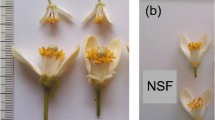Summary
In field experiments with fall and winter tomatoes, the incidence of fruit hollowness was found to range from 0 to more than 80%, depending both on the cultivar and the environment. The most resistant cultivars were Bonner Beste and Potentate; the most susceptible were Exhibiton, Moneymaker, E.S. 1, Berco, Cromco and Ailsa Craig. The rate of hollowness of F1 and F2 generations of crosses between resistant and susceptible parents suggests that resistance behaves as a partially dominant character governed by a small number of genes. Thus, commercial F1 hybrids resistant to the disorder are easy to produce. The heritability of the resistance character was found to be rather high.
Similar content being viewed by others
References
Allard, R. W., 1960. Principles of plant breeding. Wiley, New York, N.Y.
Brewbaker, J. L., 1964. Agricultural Genetics. Prentice-Hall Inc., Englewood Cliffs, N.J.
Butler, L., 1941. The inheritance of fruit size in the tomato. Can. J. Res. Sec. C. 19: 216–224.
Charles, D. R. &Smith, H. H., 1939. Distinguishing between two types of gene action in quantitative inheritance. Genetics 24: 34–48.
Friend, W. H., 1931. Tomato varieties and fertilizers for the Lower Rio Grande Valley of Texas. Bull. Tex. agric. Exp. Stn. 438.
Harrison, D. J., 1961. Influence of tomato mosaic virus infection on the hollow fruit condition of tomatoes. Nature, Lond. 192: 90–91.
Kedar, N. &Palevitch, D., 1968. Seed number, specific gravity and external appearance of hollow tomato fruits. J. hort. Sci 43: 401–407.
Khambanonda, I., 1950. Quantitative inheritance of fruit size in red peppers. Genetics 35: 322–343.
McArthur, J. W., 1941. Size inheritance in tomato fruit. J. Hered. 32: 291–295.
McArthur, J. W. &Butler, L., 1938. Size inheritance and geometric growth processes in the tomato fruit. Genetics 23: 254–268.
Palevitch, D., 1967. Studies on the puffiness of tomato fruit. Ph. D. dissertation. The Hebrew University of Jerusalem. (Hebrew, with English summary).
Powers, L., 1941. Inheritance of quantitative characters in crosses involving two species ofLycopersicon. J. agric. Res. 63: 149–174.
Sinnot, E. W., 1937. The relation of gene to character in quantitative inheritance. Proc. Nat. Acad. Sci. 23: 224–227.
Yarnell, S. H.,Friend, W. H. &Wood, J. F., 1937. Factors affecting the amount of puffing in tomatoes. Bull. Tex. agric. Exp. Stn. 541.
Young, P. A., 1957. Superpuffed locules in tomato fruits. Rep. Tomato Genet. Coop. no. 7: 16.
Author information
Authors and Affiliations
Additional information
Contribution from The Volcani Institute of Agricultural Research, Bet Dagan, Israel. 1969 Series, No. 1558-E.
Rights and permissions
About this article
Cite this article
Palevitch, D., Kedar, N. Resistance of tomato cultivars and progenies to fruit hollowness. Euphytica 19, 253–260 (1970). https://doi.org/10.1007/BF01902953
Received:
Issue Date:
DOI: https://doi.org/10.1007/BF01902953




